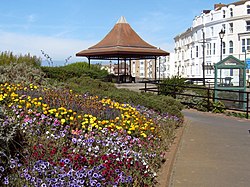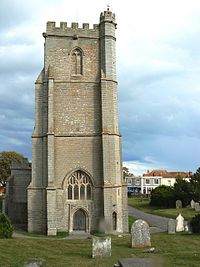Burnham-on-Sea
| Burnham-on-Sea | |
| Somerset | |
|---|---|
 the Esplanade | |
| Location | |
| Grid reference: | ST306492 |
| Location: | 51°14’15"N, 2°59’37"W |
| Data | |
| Population: | 18,401 (2001) |
| Post town: | Burnham-On-Sea |
| Postcode: | TA8 |
| Dialling code: | 01278 |
| Local Government | |
| Council: | Sedgemoor |
| Parliamentary constituency: |
Wells |
Burnham-on-Sea is a town in Somerset, at the mouth of the River Parrett where it opens into Bridgwater Bay. Burnham was a small village until the late 18th century, when it began to grow because of its popularity as a seaside resort.
Burnham is contiguous with neighbouring Highbridge and the two share a civil parish (Burnham-on-Sea and Highbridge).
The position of the town on the edge of the Somerset Levels, where they meet the Bristol Channel, has resulted in a history dominated by land reclamation and sea defences since Roman times. Burnham was overwhelmed by the waters in the Bristol Channel floods of 1607, and various flood defences have been installed since then. In 1911, a concrete sea wall was built, and after the Second World War further additions to the defences were made, using the remains of a Mulberry harbour. The present curved concrete wall was completed in 1988. There have been many shipwrecks on the Gore Sands, which lie just offshore and can be exposed at low tides. The need to protect shipping using the channel has also led to the development of the lighthouses, which are prominent landmarks. The original lighthouse, known as the Round Tower, was built to replace the light on the top of the 14th-century tower of St Andrews Church. The four-storey round tower was taken over and improved by Trinity House in 1815, and was operational until 1832. The top two storeys were later removed, to prevent confusion with the new lighthouse. The 110-foot pillar or High Lighthouse and the low wooden pile lighthouse or Lighthouse on legs on the beach were built to replace it. The town's first lifeboat was provided in 1836 by the Corporation of Bridgwater.
A stone pier was built in 1858 by the Somerset Central Railway. Soon afterwards, in 1860, a steamer service to Glamorgan was inaugurated, but it was never a commercial success, and ended in 1888. Burnham-on-Sea railway station was the terminus of the Burnham branch of the Somerset and Dorset Joint Railway. It opened in 1858, closed to scheduled passenger traffic in 1951, and stopped being used for excursions in 1962. The former Great Western Railway station is now known as Highbridge and Burnham. A second pier, built of concrete between 1911 and 1914, is claimed to be the shortest pier in Britain.
History
The name Burnham is derived from Burnhamm, as it was called in the will of King Alfred, from the Old English for "stream meadow", and the suffix "On-Sea" is a late addition to distinguish the town from several other places named Burnham.
The history of Burnham-on-Sea is the history of the reclamation of the Somerset Levels from the River Severn and the Bristol Channel. The Romans were the first peoples to try to reclaim the Somerset levels, and it was their people who were probably the first settlers in the high sand dunes behind the River Parrett.[1] This could have been in part to maintain navigational systems, to aid ships entering the River Parrett and what is now Highbridge. When the Romans fled Britain, the system of drainage they installed was not maintained, and the areas reverted to become a tidal salt flat during the Anglo Saxon period.[1]
It is likely that at the time of the Domesday Book, settlements existed at Burnham and Huntspill, their common boundary running along what is now the Westhill Rhyne.[1] The church at Burnham and its lands were given to Gloucester Abbey in the 12th century, later transferred to the Wells Cathedral along with up to 50 houses surrounding the church.[1]
One of the earliest recorded incidents to affect the town was the Bristol Channel floods of 1607,[2] which overwhelmed the town. Since that date various flood defences have been installed. In 1911 a concrete wall was built. After the Second World War, further additions to the defences against the sea were added by bringing part of the remains of a Mulberry harbour used for the Normandy Landings, and burying them in the sand. Today the town is defended from flooding by a large curved concrete wall, completed in 1988 following serious flooding in 1981. The wall runs along the Esplanade,[3] and unwillingly serves as the canvas for a wide variety of ugly graffiti.

There have been many shipwrecks on the Gore Sands. The first lifeboat was sent to Burnham by the Bridgwater Corporation in 1836, and a replacement boat in 1847.[4] The first Royal National Lifeboat was funded by the town of Cheltenham, and arrived in 1866. The lifeboat was removed in 1930 because of the difficulty in getting a full crew, and because the launching arrangements were not suitable for a powered boat. The current Burnham-on-Sea Lifeboat Station is the base for Royal National Lifeboat Institution (RNLI) search and rescue operations. The present station was opened in 2003. It operates two inshore lifeboats (ILBs), a B Class rigid-hulled boat and an inflatable D Class.
The Burnham-on-Sea Area Rescue Boat (BARB) was set up in 1992 to fund and operate rescue craft in the Bridgwater Bay area. BARB's boat house on the sea front was built in 1994 by the Challenge Anneka TV show.[5] In 2002, Lelaina Hall, a five-year-old girl from Worcester, died on the mud flats before help could reach her. The outcry over her death prompted a Western Daily Press campaign to fund an inshore hovercraft.[6] BARB currently operates the Spirit of Lelaina alongside her sister hovercraft the Light of Elizabeth, which is named after Lelaina's sister.[7]
Geography
Burnham-on-Sea is notable for its beach and mudflats, the danger they pose to individuals and shipping, and the efforts to which locals have gone in defending their town and preventing loss of life. Burnham is close to the estuary of the River Parrett where it flows into the Bristol Channel, which has the second highest tidal range in the world. At 49 feet,[8] it is second only to the Bay of Fundy in Eastern Canada.[9] Burnham's extensive mud flats are characteristic of Bridgwater Bay and the rest of the Bristol Channel, where the tide can recede for over a mile and a half; but when the tide comes in, it comes faster than a man can run. Bridgwater Bay consists of large areas of mud flats, saltmarsh, sandflats and shingle ridges, some of which are vegetated. It has been designated as a Site of Special Scientific Interest since 1989,[10] and is designated as a wetland of international importance under the Ramsar Convention.[11]
Apex Leisure and Wildlife Park, in the south-west corner of Burnham-on-Sea, north of the River Brue, occupies an area of more than 42 acres. The park was created from excavated clay pits, which were flooded, and the lakes are now home to many types of wildlife and leisure activities.[12]
Hinkley Point is a headland extending into Bridgwater Bay 5 miles west of Burnham-on-Sea, close to the mouth of the River Parrett. The landscape of Hinkley Point is dominated by two nuclear power stations.
Sights of the town

A stone pier 900 feet long was built in 1858 by the Somerset Central Railway. Soon afterwards, in 1860, a steamer service to Glamorgan was inaugurated, but it was never a commercial success, and ended in 1888. The pier retains its railway lines under a surface coating of concrete.[13]
The concrete pier, built in 1911–1914,[14] is claimed to be the shortest pier in Britain.[15] In 2008, it was rated amongst the top five piers in Britain by the Daily Express.[16]
The Esplanade along the sea front contains several listed buildings from the early 19th century, including number 44, which is also known as Steart House,[17] and numbers 46 and 47.[18]
On Berrow Road, near the High Lighthouse, numbers 4, 6 and 8 were part of a terrace built between 1838 and 1841.[19] Number 31 was previously a lodge.[20] On the corner of Berrow Road and Sea View is a drinking fountain from 1897 with a single dressed stone pier and moulded plinth, topped by a cast iron urn. Each side has the lions head design with those on the north and south sides giving water into a Purbeck Marble bowl.[21]
Churches

The parish church, St Andrew's, is a Grade I listed building dating from the 14th century.[22] It has a 78-foot high tower, which leans significantly from the vertical, caused by its poor foundations. During the 18th century, a light was placed on the tower to guide fishing boats into the harbour.[3] The church contains a number of marble carvings designed by Sir Christopher Wren for the private chapel in the Palace of Westminster.
The churches of Burnham are:
- Church of England:
- St Andrew's
- Baptist: [http://www.burnhambaptist.org.uk/ Burnham on Sea Baptist Church
- Methodist: Burnham on Sea Methodist Church
- Roman Catholic
Outside links
| ("Wikimedia Commons" has material about Burnham-on-Sea) |
References
- ↑ 1.0 1.1 1.2 1.3 Gathercole, Clare. "Burnham and Highbridge – Archeological Assessment". Somerset County Council. http://www1.somerset.gov.uk/archives/hes/downloads/EUS_BurnhamText.pdf. Retrieved 5 April 2010.
- ↑ "Burnham on Sea". Somerset Guide. http://www.somersetguide.co.uk/Burnham-on-Sea/. Retrieved 10 May 2010.
- ↑ 3.0 3.1 "Burnham on Sea Conservation Area Character Appraisal". Sedgemoor Council. pp. 12. http://www.sedgemoor.gov.uk/media/pdf/j/3/Public_Consultation_Draft.pdf. Retrieved 26 April 2010.
- ↑ "The Burnham-on-Sea Lifeboat". Roy Cox. http://www.coxresearcher.com/history/lifeboat.htm. Retrieved 5 April 2010.
- ↑ "Burnham-on-Sea History". Royal National Lifeboat Institution. http://www.rnli.org.uk/rnli_near_you/southwest/stations/burnhamonsea/history. Retrieved 10 May 2010.
- ↑ "Open day marks Lelaina Hall death". BBC. 24 July 2007. http://news.bbc.co.uk/1/hi/england/somerset/6234824.stm. Retrieved 10 May 2010.
- ↑ "Resort gets new rescue hovercraft". BBC News. 19 August 2006. http://news.bbc.co.uk/1/hi/england/somerset/5266482.stm. Retrieved 4 January 2007.
- ↑ "Severn River Basin District". Envioprnment Agency. p. 3. http://www.environment-agency.gov.uk/static/documents/Research/sev_wt_e_new_1815638.pdf. Retrieved 28 September 2010.
- ↑ "Coast: Bristol Channel". BBC. http://www.bbc.co.uk/bristol/content/articles/2005/07/04/bristolchannel_feature.shtml. Retrieved 27 August 2007.
- ↑ "SSSI citation sheet". Sites of Special Scientific Interest. English Nature. http://www.english-nature.org.uk/citation/citation_photo/1001145.pdf. Retrieved 12 November 2008.
- ↑ "Bridgwater Bay NNR". National Nature Reserves. Natural England. http://www.english-nature.org.uk/special/nnr/nnr_details.asp?NNR_ID=28. Retrieved 13 November 2008.
- ↑ "Apex Leisure and Wildlife". Day out with the kids. http://www.dayoutwiththekids.co.uk/family-fun/Apex_Leisure_and_Wildlife_Park/1321. Retrieved 10 May 2010.
- ↑ "Burnham pier, Burnham on Sea". Somerset Historic Environment Record. Somerset County Council. http://webapp1.somerset.gov.uk/her/details.asp?prn=12697. Retrieved 17 October 2008.
- ↑ "Burnham-on-Sea Pier Pavilion, Somerset". The heritage trail. http://www.theheritagetrail.co.uk/piers/burnham.htm. Retrieved 13 May 2010.
- ↑ "Webcam shows off Burnham-on-Sea seafront". BBC. http://www.bbc.co.uk/somerset/content/articles/2005/08/10/burnham_on_sea_webcam_feature.shtml. Retrieved 14 October 2008.
- ↑ Gore-Langton, Robert (11 September 1996). "Piers of the Realm". Daily Express. http://www.dailyexpress.co.uk/posts/view/60848. Retrieved 14 October 2008.
- ↑ National Heritage List 1262951: No 44 Steart House
- ↑ National Heritage List 1251418: No 46 and 47 The Esplanande
- ↑ National Heritage List 1262948: Numbers 4,6 and 8 Berrow Road
- ↑ National Heritage List 1251102: No 31 Berrow Road
- ↑ National Heritage List 1251101: Drinking Fountain at the junction of Sea View and Berrow Road
- ↑ National Heritage List 1262914: Churc of St Andrew
